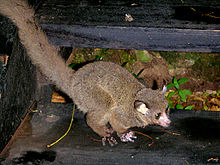Big-eared giant galago
| Big-eared giant galago | ||||||||||||
|---|---|---|---|---|---|---|---|---|---|---|---|---|

Big-eared giant galago ( Otolemur crassicaudatus ) |
||||||||||||
| Systematics | ||||||||||||
|
||||||||||||
| Scientific name | ||||||||||||
| Otolemur crassicaudatus | ||||||||||||
| ( É. Saint-Geoffroy , 1812) |
The big-eared giant galago ( Otolemur crassicaudatus ) is a primate species from the Galagos family (Galagonidae).
features
With a head body length of 30 to 37 centimeters, a tail length of 42 to 47 centimeters and a weight of 1 to 2 kilograms, giant big-eared galagos are among the largest representatives of their family. Their fur is soft and woolly, it is mostly brown or gray-brown in color, with the underside being lighter. The tail, which is longer than the trunk, is decidedly bushy. The ears are large and can move independently of each other, the eyes are also enlarged.
distribution and habitat
Big-eared giant galagos are native to eastern and southern Africa , their range extends from Kenya and Tanzania to Angola and northern South Africa . The exact dimensions of the distribution area are unclear, however, as parts of this area are inhabited by the giant silver galago . Both the systematic status of this population and its exact distribution area have not been clarified. The habitat of the big-eared giant galagos are forests, whereby they occur in different forest types.
Way of life
Like all Galagos, these primates are nocturnal tree dwellers, during the day they sleep in leaf nests. They move mainly on all fours, they jump less often than other Galagos.
These animals live in family groups of two to six animals, whose members sleep together during the day, but go for food separately at night. These groups can be composed differently, for example a couple with their offspring, two females with their children or a single female with offspring. At least the males are territorial and defend their urine-marked territory against same-sex intruders, but their territory can overlap with that of the females.
They feed on fruits, tree sap and insects, but the composition of the food can vary greatly depending on the region and season.
After a gestation period of around 133 days, the female gives birth to two to three young animals. After around a month they start eating solid food, and they are finally weaned at around five months. Sexual maturity occurs after around two years. Animals in human care can live to be over 18 years old and life expectancy in the wild is unknown.
Danger
Big-eared giant galagos are widespread and common. In some regions, such as South Africa, they have even been able to expand their range. There are no known major threats, the IUCN lists the species as "not endangered" ( least concern ).
literature
- Thomas Geissmann : Comparative Primatology. Springer-Verlag, Berlin et al. 2002, ISBN 3-540-43645-6 .
- Ronald M. Nowak: Walker's Mammals of the World. 6th edition. Johns Hopkins University Press, Baltimore MD 1999, ISBN 0-8018-5789-9 .
Web links
- Information at Animal Diversity Web
- Information at theprimata.com
- Otolemur crassicaudatus in the endangered Red List species the IUCN 2008 Posted by: S. Bearder, 2008. Accessed on 9 February, 2009.
